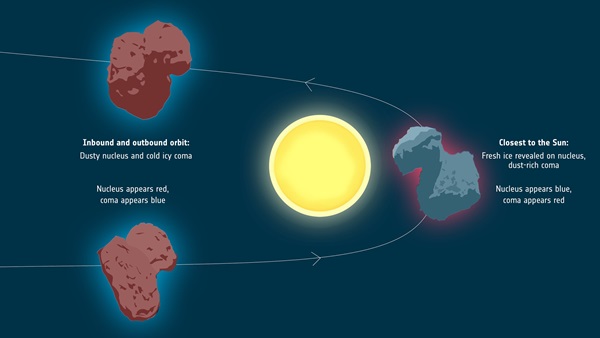Scientists chart the shifting colors of a comet’s “seasons” – Astronomy Magazine
The shifting colors of Comet 67P are the result of seasonal processes, as seen in this illustration.
ESA
The researchers looked at more than a year of data from VIRTIS and found that the wavelengths, or colors, of light the comet reflected changed as the comet got closer to and then farther from the Sun.
As the comet approached its closest point to the Sun, the atmosphere, or coma, of the comet got redder while the nucleus of the comet appeared bluer. Then, when the comet was moving further away from the Sun in its orbit, the coma got bluer while the nucleus got redder.
Cycles of ice and dust
With careful analysis and computer simulations, the researchers deduced that the color changes all came down to dust and ice. Water-ice tends to reflect bluer light, while dust grains made of carbon and organic compounds reflect more reddish light.
As the comet approached the Sun in its orbit, the Sun’s rays heated the comet and lifted lots of dust grains off of the comet’s surface and into the coma. This made the coma appear redder, while removing dust from the nucleus revealed more ice on its surface, making the nucleus look bluer.
The process flipped when the comet was in the part of its orbit that took it farther from the Sun: dust settled back onto the nucleus, making the nucleus look redder. And the particles lifted off the nucleus in this part of the orbit tended to be richer in water-ice, making the coma look bluer.
Capturing these simultaneous changes in both the coma and nucleus of Comet 67P would not have been possible with observations from Earth, Filacchione wrote in an email. But by sending a spacecraft to the vantage point of the comet’s orbit, scientists have gained a clearer picture of this icy world than ever before.







